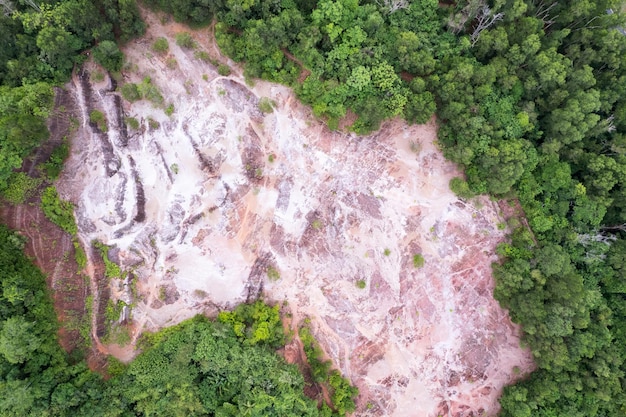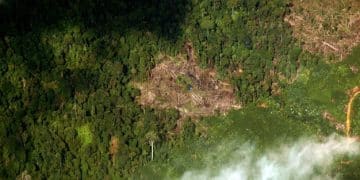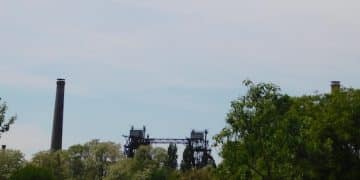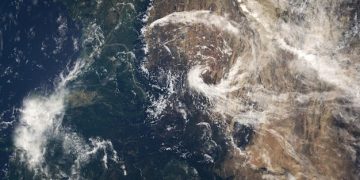Amazon Deforestation: Climate Change & US Import Impacts

Deforestation rates in the Amazon rainforest are critically linked to climate change and U.S. imports, as clearing forests releases significant carbon emissions and agricultural expansion for exports contributes to further environmental damage.
Uncover the alarming connection between deforestation rates in the Amazon: what’s the connection to climate change and US imports? It’s a cycle that threatens our planet’s future, and it’s crucial to understand the direct impact it has.
Understanding Deforestation in the Amazon
Deforestation in the Amazon is a pressing environmental issue. It involves the clearing of forested land for various purposes, leading to significant ecological and economic consequences.

The Amazon rainforest, often referred to as the “lungs of the Earth,” is rapidly diminishing due to human activities. Understanding the causes and impacts is essential.
The Primary Causes of Deforestation
Several factors contribute to deforestation in the Amazon. These include logging, agriculture, and mining.
- Logging: Illegal and legal logging operations remove vast tracts of forest, disrupting ecosystems.
- Agriculture: Cattle ranching and soy cultivation are major drivers, requiring extensive land clearing.
- Mining: Gold mining and other mineral extraction activities destroy forests and pollute rivers.
These activities not only destroy the forest but also release large amounts of carbon dioxide into the atmosphere, exacerbating climate change.
The Climate Change Connection
The Amazon rainforest plays a crucial role in regulating the global climate. Deforestation disrupts this vital function.

When forests are cleared and burned, the stored carbon is released, contributing to greenhouse gas emissions. This accelerates global warming.
Carbon Sequestration and Deforestation
Forests act as carbon sinks, absorbing carbon dioxide from the atmosphere. Deforestation reduces this capacity, leading to increased atmospheric carbon.
The loss of trees also reduces the amount of water vapor released into the atmosphere, affecting rainfall patterns and contributing to regional droughts.
Impacts on Global Weather Patterns
The Amazon’s deforestation has profound effects on global weather patterns. These include altered rainfall patterns and increased frequency of extreme weather events.
- Altered Rainfall Patterns: Deforestation leads to decreased rainfall in the region.
- Increased Temperatures: Loss of forest cover increases local and regional temperatures.
- Extreme Weather Events: Greater deforestation contributes to droughts and floods.
These weather changes can impact agriculture and water resources globally.
The Role of US Imports
US imports significantly influence deforestation rates in the Amazon. The demand for certain commodities drives agricultural expansion in the region.
Products such as beef, soy, and timber are often sourced from lands cleared from the Amazon, contributing to the ongoing deforestation.
Beef and Soy: Major Drivers
Beef and soy production are primary drivers of deforestation. Large areas of forest are cleared to create pastures for cattle and fields for soy cultivation.
Soy, in particular, is often used as animal feed. Increased demand from the US market encourages further agricultural expansion.
The expansion of these industries directly contributes to the destruction of the Amazon rainforest and the loss of biodiversity.
The Impact of Timber Imports
Timber imports, particularly illegally sourced timber, also contribute to deforestation. The demand for exotic woods encourages illegal logging activities.
- Illegal Logging: Unsustainable timber harvesting destroys vast areas of forest.
- Habitat Loss: Deforestation leads to the destruction of habitats for countless species.
- Biodiversity Loss: The Amazon’s unique biodiversity is threatened by deforestation.
Sustainable sourcing and stricter regulations are needed to mitigate the impact of timber imports.
Economic Incentives Fueling Deforestation
Economic incentives play a significant role in driving deforestation. Short-term economic gains often outweigh long-term environmental costs.
Land speculation and the conversion of forest land into profitable agricultural land incentivize deforestation, despite the environmental consequences.
The Cycle of Land Speculation
Land speculation involves the purchase of forest land for potential future profits. This encourages deforestation as land value increases once it is cleared.
Weak governance and enforcement further exacerbate the problem, allowing illegal activities to continue unchecked.
This cycle of land speculation and deforestation perpetuates the environmental degradation of the Amazon.
Short-Term Economic Gains vs. Long-Term Costs
The immediate economic benefits of deforestation often overshadow the long-term environmental costs. This creates a conflict between economic development and environmental sustainability.
- Deforestation: Leads to short term economic benefit.
- Mining: Mining creates immediate profit.
- Agriculture: Agriculture such as beef and soy give temporary value.
Balancing economic development with environmental conservation is crucial for the long-term sustainability of the Amazon rainforest.
Potential Solutions and Mitigation Strategies
Addressing deforestation requires a multifaceted approach. This includes implementing stricter environmental regulations, promoting sustainable practices, and raising awareness.
International cooperation and consumer action are also essential in mitigating the impact of US imports on deforestation rates.
Enhancing Environmental Regulations
Stronger environmental regulations are necessary to protect the Amazon rainforest. This includes stricter enforcement of existing laws and the implementation of new policies.
Monitoring and surveillance technologies can help detect and prevent illegal deforestation activities.
Governmental oversight is crucial to protect the forest and its biodiversity.
Promoting Sustainable Practices
Promoting sustainable agricultural and forestry practices can reduce the pressure on the Amazon rainforest. This involves implementing techniques that minimize environmental impact and maximize productivity.
- Sustainable Agriculture: Promotes crop rotation and limits clear cutting.
- Sustainable Forestry: Allows selective cutting.
- Agroforesty: Combines trees and shrubs into agricultural systems.
Sustainable practices can help balance economic development with environmental conservation.
The Role of Consumers and Policymakers
Consumers and policymakers play a critical role in addressing deforestation. Consumer choices and policy decisions can significantly impact the demand for products linked to deforestation.
Supporting sustainable products and advocating for stricter regulations can help reduce deforestation rates in the Amazon.
Consumer Awareness and Sustainable Choices
Consumer awareness is essential. When consumers are informed about the impact of their purchases, they can make more sustainable choices.
Supporting companies committed to sustainable sourcing and avoiding products linked to deforestation can drive positive change.
Responsible consumption habits are crucial for protecting the Amazon rainforest.
Policy and International Collaboration
Government policies and international cooperation are vital for addressing deforestation. Strengthening trade agreements and implementing environmental safeguards can promote sustainable practices.
- Stringent Trade Agreements: Implement environmental regulations.
- Environmental Safeguards: Avoid products that are destructive.
- Subsidies: Give economic incentives to use sustainable product creation.
Through collective action, consumers and policymakers can help preserve the Amazon rainforest and mitigate the impacts of climate change.
| Key Point | Brief Description |
|---|---|
| 🔥 Amazon Deforestation | Clearing forests for agriculture and logging has disastrous effects. |
| 🌍 Climate Impact | Deforestation releases carbon, intensifying global warming. |
| 🥩 US Imports | Demand for beef, soy, and timber drives deforestation in the Amazon. |
| 🌱 Sustainable Practices | Adopting eco-friendly methods can mitigate deforestation. |
Frequently Asked Questions
The main drivers include agriculture, especially cattle ranching and soy cultivation, alongside logging and mining activities, which clear vast areas.
Deforestation releases stored carbon into the atmosphere, reducing carbon sinks and exacerbating global warming by increasing greenhouse gas concentrations.
Beef, soy (used as animal feed), and timber are the primary imports connected to converting rainforest into agricultural land or logging areas.
Consumers can choose sustainably sourced products, reduce meat consumption, and support companies committed to environmental responsibility, influencing market practices.
Environmental laws, trade agreements, and forest monitoring systems are in place, but enforcement and international cooperation need strengthening to effectively combat deforestation.
Conclusion
Understanding the intricacies of deforestation rates in the Amazon: what’s the connection to climate change and US imports?, is crucial. By adopting sustainable practices, raising consumer awareness, and promoting responsible policies, we can collectively mitigate these alarming trends and protect the world’s most vital rainforest.





